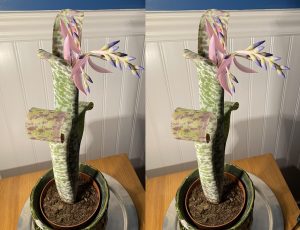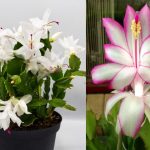
1. Understanding the Quesnelia marmorata
Before we dive into care tips, let’s start by getting to know the plant. Native to Brazil, the Quesnelia marmorata is often found in the tropical rainforests, which gives you a clue about the environment it thrives in. With its unique rosette of thick, leathery leaves that often display variegated patterns of green, white, and purple, this plant is an excellent addition to any collection of tropical or bromeliad plants.
Unlike many other plants, the Quesnelia marmorata doesn’t require soil to thrive. Like other members of the bromeliad family, it can grow epiphytically, meaning it can grow on trees or rocks, where it absorbs moisture and nutrients through its leaves rather than through roots in the soil. While this plant is relatively low-maintenance, it does have a few specific needs to ensure it flourishes and produces its distinctive flower spike.
2. Optimal Lighting Conditions
Light is crucial to the health and blooming of the Quesnelia marmorata. In its native habitat, it would receive dappled sunlight filtering through the tree canopy, so replicating this in your home is key.
- Ideal Light: Bright, indirect light is the best for your plant. Direct sunlight can scorch its delicate leaves, so avoid placing it in spots where it will get full, direct sun for extended periods.
- Signs of Too Much Light: If the plant’s leaves start to fade or become crispy around the edges, it may be receiving too much light.
- Signs of Too Little Light: If the leaves become long and leggy, or if the plant shows little to no growth, it could be a sign it’s not getting enough light.
3. Watering Tips
Bromeliads like the Quesnelia marmorata are epiphytes, meaning they absorb moisture and nutrients through their leaves. This means the plant’s «cup»—the central rosette where the leaves come together—should be kept filled with water. Here’s how to handle watering:
- Watering the Cup: Always keep the central rosette filled with water, but make sure you change it every few days to avoid stagnation and the growth of mold or bacteria.
- Watering the Soil: If you have your Quesnelia marmorata potted, keep the soil lightly moist, but not soggy. It’s important to use a well-draining soil mix designed for bromeliads, such as a mix of orchid bark and perlite.
- Humidity: This plant thrives in a humid environment, so if your home is dry, consider placing a humidifier nearby or setting the plant on a pebble tray filled with water to increase humidity around it.
4. Temperature and Airflow
As a tropical plant, the Quesnelia marmorata prefers warm temperatures and good air circulation. Ideal temperatures range from 65°F to 85°F (18°C to 29°C).
- Avoid Cold Drafts: Protect the plant from drafts or sudden temperature changes, as cold air can damage its delicate leaves.
- Air Circulation: While it loves humidity, the Quesnelia marmorata also appreciates good airflow. Avoid placing it in a completely stagnant area. A gentle breeze or a fan can help, especially in the warmer months.
5. Fertilizing the Quesnelia marmorata
While the Quesnelia marmorata isn’t a heavy feeder, it can benefit from a bit of fertilizer to support its growth and flowering. During the growing season (spring and summer), feed your plant with a diluted, balanced liquid fertilizer about once a month.
- Fertilizing Tip: A good option is a 10-10-10 (NPK) liquid fertilizer, diluted to one-quarter strength. Be sure not to over-fertilize, as this can lead to leaf burn and other issues.
- Fertilize in the Water Reservoir: You can also add diluted fertilizer directly to the water-filled «cup» of the plant. This provides nutrients directly to the area where the plant is most likely to absorb them.
6. Encouraging Blooming
One of the most remarkable features of the Quesnelia marmorata is its showy bloom, which can be a true reward for all your care. The plant produces a vibrant flower spike that emerges from the center of the rosette, typically in the late winter or early spring.
- Encouraging Flowers: While some bromeliads need a temperature drop or a specific light cycle to bloom, the Quesnelia marmorata is generally less picky. It may flower with just the right care, good light, and enough water in its cup.
- Supportive Conditions: To promote blooming, ensure your plant receives plenty of bright, indirect light and the proper amount of water. If the plant hasn’t bloomed within a year or two, try giving it a bit more fertilizer or adjusting its light exposure.
7. Caring for Quesnelia marmorata After Blooming
After your Quesnelia marmorata blooms, it may die back slowly, as many bromeliads do. However, don’t worry—new pups (offsets) will likely emerge from the base of the plant. These pups are the future of your bromeliad garden!
- Cutting Back: Once the flower has faded, you can cut back the bloom stalk, but be careful not to disturb the pups.
- Pups: Wait for the pups to reach at least one-third of the size of the parent plant before separating them. This will ensure that they have enough strength to thrive on their own.
8. Common Pests and Problems
Like most plants, Quesnelia marmorata can occasionally be affected by pests such as mealybugs, aphids, or scale. Inspect your plant regularly, especially on the undersides of the leaves and in the water cup. If pests are present, treat with a gentle insecticidal soap or neem oil.
- Leaf Issues: If you notice brown tips, it could be a sign of underwatering, inconsistent watering, or low humidity. Keep the water level in the central cup steady, and increase humidity if needed.
Final Thoughts
Caring for the Quesnelia marmorata can be incredibly rewarding, especially when you see it bloom in a burst of vibrant color. By providing it with the right balance of light, water, humidity, and occasional fertilizer, your plant will thrive, bringing a touch of tropical beauty to your home. With a little patience and attention, you’ll enjoy the lush foliage and spectacular flower spike that make the Quesnelia marmorata such a prized bromeliad.
Happy planting, and may your Quesnelia marmorata flourish beautifully! 🌿



